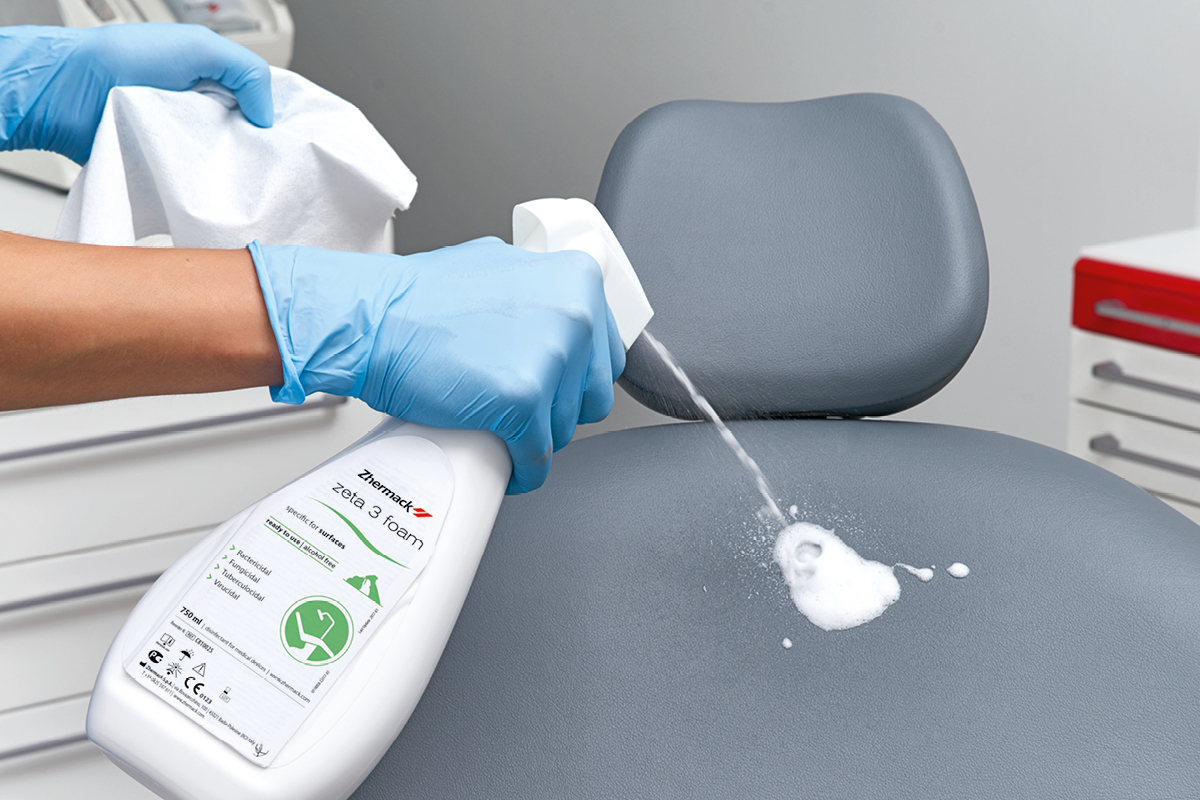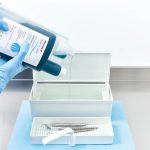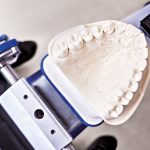21
Oct
Cleaning and disinfection of surfaces are actions of paramount importance in preventing the spread of infection

In a dental practice, it must be assumed that, during patient treatment, the work area is contaminated by spraying and contact with saliva mixed with blood. Consequently, in order to prevent cross-infection, the worktops and furnishings must be decontaminated using a low or intermediate level disinfectant when a patient leaves the treatment room, and before the next patient arrives.1 This involves the adoption of a wet-dry disinfection technique in which the surfaces are completely and systematically wetted using disposable disinfectant-impregnated cloth. Once the contact time has elapsed, if necessary, the surfaces can be dried using another disposable cloth 2.
In order to identify the most suitable treatment, it is necessary to consider:
a) the manufacturer’s instructions for use accompanying the purchased devices
c) the disinfectants provided and the characteristics indicated on the technical and safety data sheets.
b) classification of items according to the potential risk of infection resulting from their use, using the scheme proposed by Spaulding in 1968. This classification scheme identifies three levels of criticality:
- Critical (high-risk) items are those that penetrate sterile tissues and therefore come into contact with blood, damaged mucous membranes and bone, those that penetrate the tissues or vascular system, or through which blood passes. For these items the requirement is absolute sterility, they must be pre-cleaned, disinfected and sterilised before use.
- Semi-critical (medium-risk) items are those that come into contact with intact mucous membranes or broken skin. For these items the requirement is desirable sterility and high-level disinfection before use. These items should therefore be appropriately pre-cleaned and, as a minimum, high-level disinfection is required. Sterilisation is preferable, if compatible with the item.
- Non-critical (low-risk) items come into contact with intact skin and have a low risk of transmitting infection, except for the transfer of pathogens by means of the hands of healthcare professionals. For these items the requirement is low-intermediate level disinfection. They must be pre-cleaned and disinfected before use.
Surfaces in healthcare settings that are frequently touched, especially those found in the patient’s immediate vicinity, require routine decontamination between patients, in order to prevent pathogen transmission to the hands.
The areas of a dental care facility can be classified by risk level, and this kind of classification provides useful information for understanding, more specifically, where and with what substances surface disinfection is required:
- High-risk areas: contaminated surfaces (work tops, equipment that comes into contact with infected material). Disinfection after each patient is recommended
- Intermediate risk areas: work surfaces (dental practice floors and furniture). Daily sanitisation is recommended, weekly sanitisation of the whole environment. Daily sanitisation of the most frequently used surfaces (handles, switches, floors).
- Low-risk areas: administrative area surfaces (offices, recreational areas, store rooms, etc.). Daily sanitisation is recommended, monthly sanitisation 3
The contaminated surfaces to be disinfected after an operating session are:4
- The horizontal surfaces adjacent to the operating area: mobile cabinets and work tops.
- Dental treatment unit and chair: headrest, armrests, instrument tray, switches and controls, spittoon, lamp handles, seat and saliva ejector tubings, supports and ducts of the handpieces and three-way syringe.
- Seat: armrests and levers
- X-ray equipment: head, cone, handle, film dispenser, developing box
- Accidentally-touched surfaces: telephone, switches, etc.
Zeta 3 products developed by Zhermack for quick and thorough disinfection of even the most delicate surfaces are alcohol-reduced or alcohol free, easy to use, and free of phenols and aldehydes – toxic substances. The range consists of sprays and wipes for effective one-step cleaning and disinfection (2-in-1 action) that guarantee an adequate level of protection and time savings.
Bibliography
1 W. A. Rutala, D. J. Weber et al., Guideline for disinfection and sterilization in healthcare facilities, 2008, 91
2 Linee Guida per la qualità – Igiene nello studio odontoiatrico. Swiss Dental Journal SSO. 2015; Vol. 125 2: 255.
3 F. Montagna, G. Bevilacqua. Associazione Nazionale Dentisti Italiani. Prevenzione delle infezioni in odontoiatria: epatiti e AIDS. Mansionari per il personale ausiliario odontoiatrico. January 1997- Part E- Chap.5 – Tab. 2, page 307.
4 F. Montagna, G. Bevilacqua. Associazione Nazionale Dentisti Italiani. Prevenzione delle infezioni in odontoiatria: epatiti e AIDS. Mansionari per il personale ausiliario odontoiatrico. January 1997- Part E- Chap.5 – Tab. 6, pag. 310.
Are you interested in Zhermack's materials?
Contact Us




 Zhermack SpA has been one of the most important producers and international distributors of alginates, gypsums and silicone compounds for the dental sector for over 40 years. It has also developed solutions for the industrial and wellbeing sectors.
Zhermack SpA - Via Bovazecchino, 100 - 45021 Badia Polesine (RO), Italy.
Zhermack SpA has been one of the most important producers and international distributors of alginates, gypsums and silicone compounds for the dental sector for over 40 years. It has also developed solutions for the industrial and wellbeing sectors.
Zhermack SpA - Via Bovazecchino, 100 - 45021 Badia Polesine (RO), Italy.


